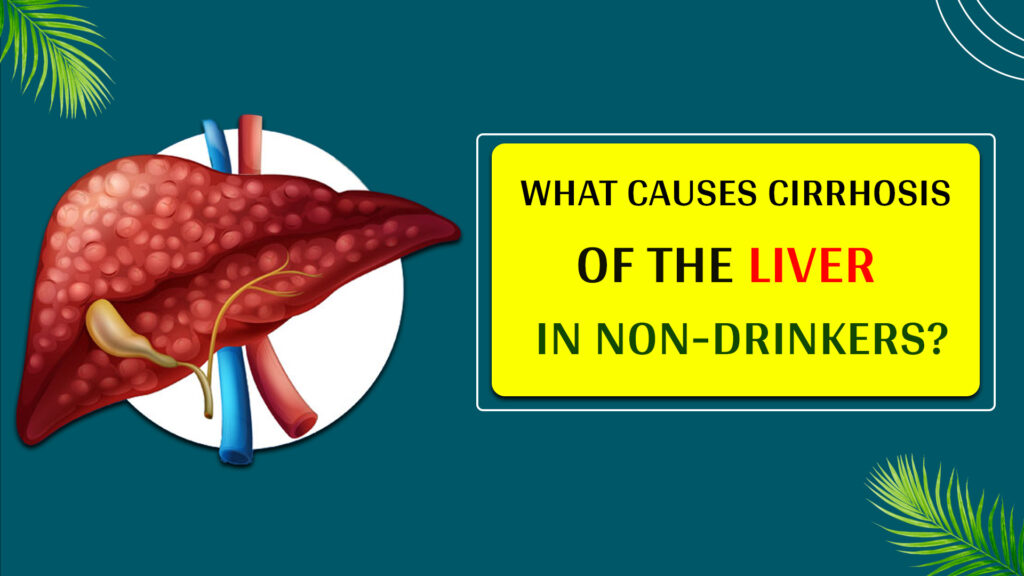Significant causes behind Non-alcoholic Liver Cirrhosis
Cirrhosis is the end-stage of many long-term liver conditions. As the cases of obesity and metabolic syndrome continue to rise, nonalcoholic fatty liver disease (NAFLD) has emerged as the most dominant cause of chronic liver disease globally, and it is expected to become one of the leading causes of liver cirrhosis.
While many people believe that liver diseases only affect individuals who are involved in the practices of heavy drinking, increasing awareness and understanding of non-alcoholic factors that can lead to cirrhosis is essential. Thus, in this blog, we will be mentioning the most common causes of cirrhosis in non-drinkers.
A brief about Cirrhosis
The structural features of the human body comprise multiple organs and systems. The liver, located in the upper right intersection of the abdominal cavity, is part of our digestive system. A person is said to have a “healthy liver” if the organ works efficiently and smoothly. In case the organ becomes incapable of completing its tasks, we can conclude that there is some amount of damage present in the liver, and it is in an “unhealthy” state.
If the damage keeps on progressing, most of the healthy tissues of the organ get replaced with scar tissues, gradually leading to the development of end-stage liver disease, cirrhosis. While alcohol is considered to be the most common factor behind liver-related health issues, there are many non-alcoholic factors also that can cause severe damage to the organ.
What causes cirrhosis besides alcohol?
Besides nonalcoholic fatty liver disease, certain inherited as well as autoimmune conditions come forward as a notable cause behind cirrhosis. Below, we have discussed all of them in detail;
1.Non-alcoholic fatty liver disease (NAFLD):
As the name suggests, NAFLD is a form of liver disease in which extra amounts of fat accumulate in the organ due to non-alcoholic factors. While the early stage of the condition might not cause any significant health problems, if left untreated, Non-alcoholic fatty liver can lead to severe damage, increasing your likelihood of developing symptoms of liver cirrhosis.
2.Non-alcoholic steatohepatitis (NASH):
NASH can be simply understood as the 2nd stage of non-alcoholic fatty liver disease. In this condition, along with fat accumulation, the organ starts to experience inflammation. This abnormal inflammation can cause fibrosis or scarring of the organ tissues. The condition can also lead to cirrhosis.
3.Inherited conditions:
While cirrhosis itself is not at all a genetic disorder, certain hereditary medical conditions can seriously impair liver functions, leading to Cirrhosis. Such medical conditions include;
- Wilson’s disease: It is a rare genetic issue in which the body is incapable of removing excess copper. This causes copper to get deposited in the liver. This copper damages the cells of the organ to a great extent.
- Hemochromatosis: In this genetic disorder, extra iron builds up in the body. Multiple organs can be damaged due to this iron overload, including the heart, joints, and liver.
- Alpha-1 antitrypsin deficiency: AATD is a congenital condition that can cause liver damage. In this disorder, a wrongly shaped protein builds up in the organ, leading to swelling and scar tissue. This can eventually result in serious disease.
4.Bile duct problems:
Bile duct issues, especially if they cause long-term blockage, can lead to cirrhosis, known as “biliary cirrhosis.” This happens when bile builds up in the liver and scars the organ tissue because the bile ducts are damaged. It is often linked to autoimmune diseases, like primary biliary cholangitis (PBC), where the immune system attacks the bile ducts.
5.Immune system problems:
Some issues with the immune system, especially autoimmune diseases like autoimmune hepatitis, can cause cirrhosis. This happens because they lead to long-term inflammation and damage to liver cells, resulting in scarring and fibrosis, which are key signs of cirrhosis.
6.Too much body fat:
If you are obese and consume a high-calorie diet, this can lead to fat deposits in your liver. These fat deposits can cause gradual and progressive damage to the organ, further leading to scarring of the organ tissue. Progressing from a fatty liver can lead to severe stages of liver cirrhosis and even complete failure of the organ.
7.High Cholesterol levels:
High cholesterol levels can lead to the growth of cirrhosis, primarily by increasing the risk of nonalcoholic fatty liver disease (NAFLD). If NAFLD progresses, it can lead to scarring (cirrhosis) due to inflammation and damage to liver cells.
8.Having type 2 diabetes:
Type 2 diabetes can seriously increase the risk of liver damage, primarily through the development of nonalcoholic fatty liver disease (NAFLD). If left untreated, NAFLD can progress to more severe conditions such as nonalcoholic steatohepatitis (NASH) and even cirrhosis. Over time, high blood sugar levels can impair organ tissue, making individuals with type 2 diabetes more susceptible to liver complications.
9.Having high blood pressure:
High blood pressure (hypertension) can also lead to liver damage, particularly by increasing the risk of developing nonalcoholic fatty liver disease (NAFLD). This relationship is often seen as bidirectional, where high blood pressure can worsen liver health and vice versa.
So, these were the most critical factors that can lead to liver cirrhosis other than alcohol. A diagnosis of this condition can be quite distressing. Although it might generate the need for special care of a patient’s health, cirrhosis is a manageable condition. In fact, with the advancement in medical science, patients can still live a normal life with cirrhosis.
Can liver failure be prevented after cirrhosis?
From the above sections, one can easily understand that cirrhosis can develop in individuals for a variety of reasons. Determining the underlying cause behind the condition and treating it from its root levels is the key to preventing further scaring of the cells and minimizing the chances of liver failure.
Homeopathy, an age-old medical system, has proven its efficacy over the years in treating multiple liver-related disorders. Comprehensively analyzing the patient’s condition and prescribing highly customized medicines designed to work on the root cause are the two main principles followed by homeopathic practitioners for liver cirrhosis treatment.
This approach can definitely benefit patients in controlling the further progression of the condition and restoring organ function with safe and side-effect-free remedies. The homeopathic treatment for liver cirrhosis can show even greater results if the treatment is begun early enough.
Why choose us?
With long-term relief from the symptoms, improved quality of life, and a completely non-invasive cure at Bharat Homeopathy, patients can get a completely natural homeopathic treatment for liver cirrhosis with top liver experts.
Our liver is a versatile organ, and it can regenerate itself even after facing 80-90% damage. However, sometimes, the organ’s ability to heal itself gets affected due to certain factors. Resolving these underlying causative factors behind liver damage with the help of our homeopathic medicine for liver will gradually revive the organ’s self-healing ability and restore its health. To avail the benefits of our best homeopathy medicine for vata dosha present in your, you can either visit our clinic in Gurgaon or even consult our doctors online. For further inquiries, give us a call today on our helpline numbers.


